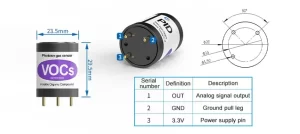Environmental safety and protection have become crucial global concerns in recent years. With the increasing pollution levels and their adverse effects on human health and ecosystems, effective pollution detection and monitoring systems are essential. Gas sensors have emerged as a key tool in improving environmental safety by providing accurate and real-time data on pollutant concentrations. This article explores the significance of gas sensors in pollution detection and their role in enhancing environmental safety.
The Importance of Pollution Detection:
Pollution poses significant threats to the environment, public health, and the overall well-being of living organisms. It arises from various sources, including industrial emissions, vehicular exhaust, agricultural activities, and improper waste management. Detecting pollutants in the air, water, and soil is crucial to understanding the extent of contamination and formulating appropriate measures for mitigation and control.
Gas Sensors: An Overview:
Gas sensors are electronic devices designed to detect and measure specific gases in the environment. They operate based on various principles, such as electrochemical, semiconductor, and optical sensing. Gas sensors can detect a wide range of pollutants, including carbon monoxide (CO), nitrogen dioxide (NO2), ozone (O3), sulfur dioxide (SO2), volatile organic compounds (VOCs), and particulate matter (PM). These sensors provide real-time measurements, allowing for immediate action to be taken in response to pollution incidents.
Applications of Gas Sensors in Pollution Detection:
Gas sensors find applications in various domains to detect and monitor pollution levels:
a. Industrial Emissions Monitoring: Gas sensors are widely used in industrial settings to monitor emissions and ensure compliance with environmental regulations. Continuous monitoring of gases like CO, SO2, and NO2 helps identify pollution hotspots and enables timely intervention to reduce environmental impact.
b. Indoor Air Quality Monitoring: Gas sensors play a crucial role in monitoring indoor air quality in homes, offices, schools, and other enclosed spaces. They detect pollutants like CO2, VOCs, and PM, which can have adverse effects on human health. Prompt detection and mitigation of indoor air pollutants contribute to a healthier indoor environment.
c. Vehicle Emissions Testing: Gas sensors are employed in emission testing centers to measure the exhaust gases from vehicles. By detecting pollutants such as CO, NO2, and hydrocarbons, gas sensors help identify vehicles that do not comply with emission standards, promoting cleaner transportation and reducing pollution from vehicles.
d. Environmental Monitoring Networks: Gas sensors are integrated into environmental monitoring networks to provide comprehensive and real-time data on pollutant concentrations. These networks allow for the continuous monitoring of air, water, and soil quality in different locations, facilitating early detection of pollution sources and informed decision-making.
Advantages of Gas Sensors in Pollution Detection:
The use of gas sensors offers several advantages in pollution detection:
a. Real-time Monitoring: Gas sensors provide immediate and continuous measurements of pollutant concentrations. This real-time data allows for quick identification of pollution incidents and enables timely intervention to minimize their impact.
b. Accuracy and Specificity: Gas sensors are highly accurate and specific in detecting particular gases. They can differentiate between different pollutants, providing precise information on their respective concentrations. This specificity facilitates targeted pollution control measures.
c. Cost-effectiveness: Gas sensors offer a cost-effective solution for pollution detection compared to traditional methods. They eliminate the need for manual sample collection and laboratory analysis, reducing costs and providing faster results.
d. Portability and Accessibility: Gas sensors come in various sizes and formats, ranging from handheld devices to stationary monitors. This portability allows for easy deployment in different settings, including remote areas with limited infrastructure. Gas sensor data can be accessed remotely, enhancing accessibility and data sharing.
Emerging Trends in Gas Sensor Technology:
Gas sensor technology is continually evolving to enhance pollution detection capabilities:
a. Miniaturization: Advances in miniaturization have led to the development of small, portable gas sensors that can be integrated into wearable devices or drones. This miniaturization enables monitoring in hard-to-reach areas and facilitates personal exposure monitoring.
b. Wireless Connectivity: Gas sensors equipped with wireless connectivity enable remote data transmission and real-time monitoring. This connectivity allows for the integration of gas sensors into Internet of Things (IoT) networks, enhancing data sharing and analysis.
c. Sensor Arr
 : +86 155 8830 2704
: +86 155 8830 2704 : jxdziot@gmail.com
: jxdziot@gmail.com
